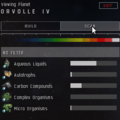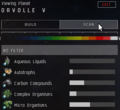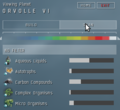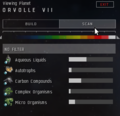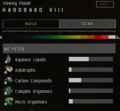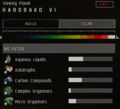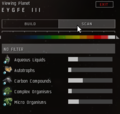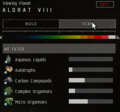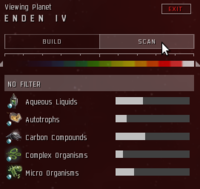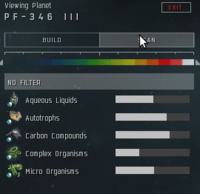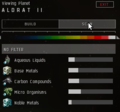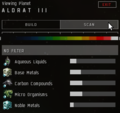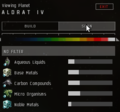More actions
Haddri ruld (talk | contribs) |
m fixed a typo in a system name |
||
| (9 intermediate revisions by 5 users not shown) | |||
| Line 1: | Line 1: | ||
{{cleanup|Article should be revised to reflect a less casual tone/style.}} | |||
{{PlanetaryIndustryNav}} | |||
So now it's time to shop for a suitable planet. You have read up on what is made from of what on the [[Setting up a planetary colony]] page, and you have decided to make something. Now you need to find one or more planets that will keep your assembly line going. As you might expect, the abundance of resources on a planet is affected by the system's Security Status, but this is not the only consideration. If you want to make a whole product chain on one planet, you need to look at the mix of resources available too. | |||
So now it's time to shop for a suitable planet. You have read up on what is made from of what on the [[ | |||
| Line 21: | Line 20: | ||
To start off, let us make this simple and look at the abundance of something that will always require more than one planet, which means you can focus on just the one resource. Lava planets are the only source of Felsmic Magma, which is processed into Silicon. Below is a sampling of various lava planets of different security levels. | To start off, let us make this simple and look at the abundance of something that will always require more than one planet, which means you can focus on just the one resource. Lava planets are the only source of Felsmic Magma, which is processed into Silicon. Below is a sampling of various lava planets of different security levels. | ||
In highsec, you will note that | In highsec, you will note that Loguttur II and Aldrat I are singularly poor examples of Lava planets, having pretty much no Felsmic Magma at all, while Vullat IV is a rather good Lava Planet, having deposits that rival a lot of lower security systems in the highsec class. In any case though, you are not very likely to find any Lava Planets with huge supplies of Felsmic Magma, but if you look around, you can find some fairly decent ones. | ||
Moving to lowsec, we can see that Erstet VIII has no more Felsmic Magma than Vullat IV, despite having all the attached dangers of low security space. On the other hand, Erstet II has about double the abundance of the high sec systems. However, if we are going to dabble around in low sec, we might as well go all-in and jump to Egmar, Helgatild, or Todifrauan. | Moving to lowsec, we can see that Erstet VIII has no more Felsmic Magma than Vullat IV, despite having all the attached dangers of low security space. On the other hand, Erstet II has about double the abundance of the high sec systems. However, if we are going to dabble around in low sec, we might as well go all-in and jump to Egmar, Helgatild, or Todifrauan. | ||
| Line 253: | Line 252: | ||
* Nanites come from Micro Organisms and Base Metals, a combination only available on Barren worlds. | * Nanites come from Micro Organisms and Base Metals, a combination only available on Barren worlds. | ||
Note that Eygfe III would be a good planet to produce Test Cultures, since it has equal parts Micro Organisms (makes Bacteria) and Aquaeous Liquid (makes Water), meaning that you are not filling your storage with extra stuff you do not need. This would of course depend on the exact distribution of those two resources as well as their abundance. If we found a planet that has 30% Aqueous Liquids, and 30% Micro | Note that Eygfe III would be a good planet to produce Test Cultures, since it has equal parts Micro Organisms (makes Bacteria) and Aquaeous Liquid (makes Water), meaning that you are not filling your storage with extra stuff you do not need. This would of course depend on the exact distribution of those two resources as well as their abundance. If we found a planet that has 30% Aqueous Liquids, and 30% Micro Organisms, this is a good choice. However, what if we found a planet with 30% Aqueous Liquids and 40% Micro Organisms. If we are willing to collect the excess Micro Organisms on a regular basis, we can produce the Test Cultures, and have a small amount of extra revenue selling Bacteria to producers of Nanites, sited on Barren worlds where the abundance of Micro Organisms is less than on the Oceanic world we chose. (We obviously would not be selling to people on Aldrat II, III, or IV, who have chosen a good planet for making Nanites (equal quantities of Micro Organisms and Base Metals), threatening to make this an appallingly poor teaching example.) | ||
| Line 261: | Line 260: | ||
File:PI_Barren6-Aldrat_IV.png | File:PI_Barren6-Aldrat_IV.png | ||
</gallery> | </gallery> | ||
= Planet Radius = | = Planet Radius = | ||
| Line 297: | Line 295: | ||
This will take scanning and placement of actual extractors, so it will take more in-person work than the resource bars, since that can be done by anybody anywhere without any sort of skills. | This will take scanning and placement of actual extractors, so it will take more in-person work than the resource bars, since that can be done by anybody anywhere without any sort of skills. | ||
[[Category:Guides]] | |||
[[Category:Planetary Industry]] | |||
Latest revision as of 20:19, 19 March 2024
The reason is: Article should be revised to reflect a less casual tone/style.
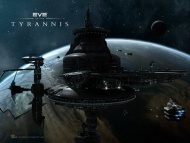
|
| Planetary Industry |
|---|
| Introduction to PI |
| The Basics |
| Advanced |
| Other Resources |
So now it's time to shop for a suitable planet. You have read up on what is made from of what on the Setting up a planetary colony page, and you have decided to make something. Now you need to find one or more planets that will keep your assembly line going. As you might expect, the abundance of resources on a planet is affected by the system's Security Status, but this is not the only consideration. If you want to make a whole product chain on one planet, you need to look at the mix of resources available too.
There are about 42,000 planets in the EVE universe, and some are Oceanic, some Lava, some Temperate. Some are located in highsec, some in lowsec, some in nullsec, and some in wormhole space. With such a range of choice, how do you pick the 1-6 planets that you want to commit your capital to?
Several variables come into play in making this decision:
- Whether you need a specific product for your goal, or are maximizing profit from resource extraction
- The abundance of the product you need for the goal
- The relative abundance of the multiple products you need to achieve the goal
- The radius of the planet, which determines the cost of all of its links
Resource Abundance by Sec Status
As with mining or ratting, better yields can be found in lower security space. Looking at this effect alone lets us focus on one of the several variables you need to look at.
To start off, let us make this simple and look at the abundance of something that will always require more than one planet, which means you can focus on just the one resource. Lava planets are the only source of Felsmic Magma, which is processed into Silicon. Below is a sampling of various lava planets of different security levels.
In highsec, you will note that Loguttur II and Aldrat I are singularly poor examples of Lava planets, having pretty much no Felsmic Magma at all, while Vullat IV is a rather good Lava Planet, having deposits that rival a lot of lower security systems in the highsec class. In any case though, you are not very likely to find any Lava Planets with huge supplies of Felsmic Magma, but if you look around, you can find some fairly decent ones.
Moving to lowsec, we can see that Erstet VIII has no more Felsmic Magma than Vullat IV, despite having all the attached dangers of low security space. On the other hand, Erstet II has about double the abundance of the high sec systems. However, if we are going to dabble around in low sec, we might as well go all-in and jump to Egmar, Helgatild, or Todifrauan.
Finally, we could move into 0.0, but be careful -- to avoid being killed, obviously, but also to avoid planets like PF-346 I, where we can find all the dangers of 0.0, but an abundance that is half or less than that of many High Sec planets. On the other hand, we could strike it lucky and find a planet like 93PI-4 I where Felsmic Magma is greater than half-way across the scale. Likely there might even be some planets that are even better.
(I can only conjecture that Wormholes are similar to 0.0, and likely the higher the class, the better.)
This survey suggests that the effect of security status on abundance is less linear security status, and more simply where it falls into the three classes of highsec, lowsec and nullsec.
Note: these distributions were collected on Singularity server on 2010 May 9, so they may not be valid now that Tyranis has gone live on Tranquility.
Lava
| Sec Status | Examples |
|---|---|
| 1.0 | 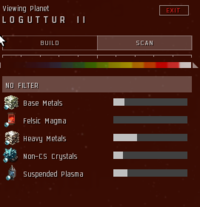 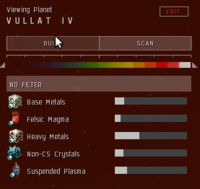 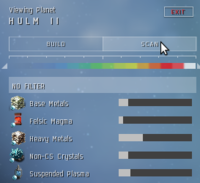
|
| 0.9 | 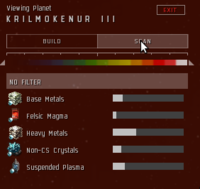
|
| 0.8 | 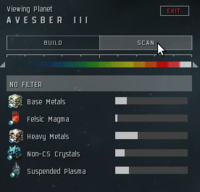
|
| 0.7 | 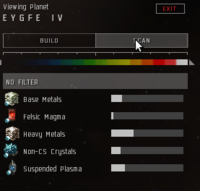 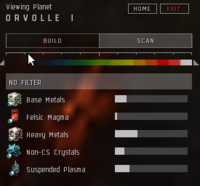
|
| 0.6 | 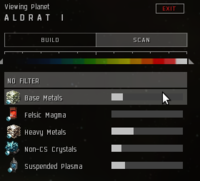
|
| 0.5 | 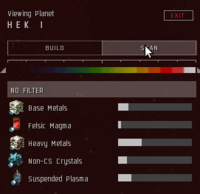 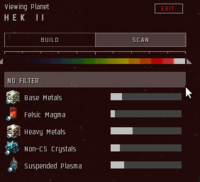 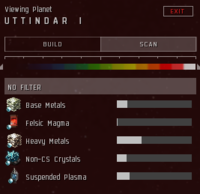 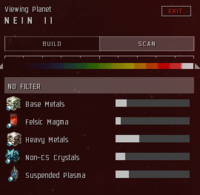
|
| 0.4 | 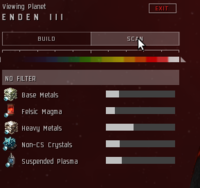 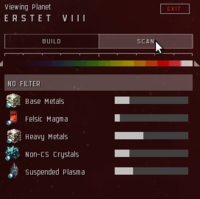 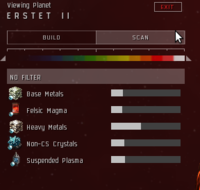
|
| 0.3 | 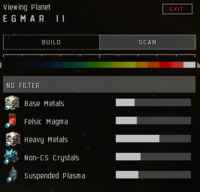 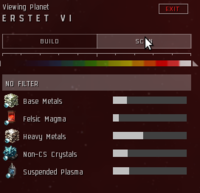
|
| 0.2 | 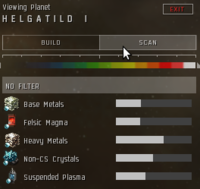
|
| 0.1 | 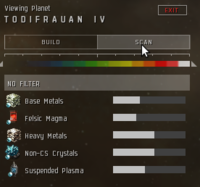
|
| 0.0 | 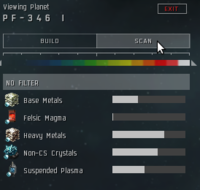 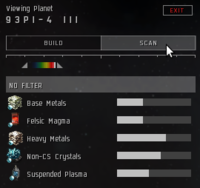 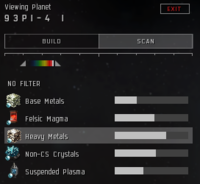
|
Temperate
So that we are not limiting the conversation to just one planet type, let us see if this effect bears out for another type of planet. Temperate planets are the only place you can find Autotrophs, from which you can make Industrial Fibers. As you can see, we do have a bit of variation, but our prospects seem better for these than Felsmic Magma, particularly since Temperate planets are somewhat more common than Lava planets. Orvolle IV is not a very good planet at all, but Orvolle V, Hardbako VI, Aldrat VIII or Eygfe III would be good places to setup for High Sec Industrial Fiber production.
As can be expected, moving into lowsec or 0.0 improves the results, with a very impressive yield in PF-346 III (in comparison to the improvement we saw in Felsmic Magma.)
Hi Sec
Looking at the Temperate distributions in Orvolle (0.7) shows how you must base you decision on your target product:
Let us check out some more locations in High Security space: Hardbako (0.7), Eygfe (0.7) and Aldrat (0.6)
Low Sec and 0.0
Ok, our processors are not really running at full capacity on Orvolle V, so let's try moving to Low Sec, for example Enden (0.4). Clearly we are getting more Autotrophs, but the distribution of other products is similar to some of our high sec examples.
While clearly low sec and 0.0 will get you generally better results, there are also some gems in High Sec just waiting to be discovered, depending on the products you want to produce.
Resource Abundance by Planet Type
We know that you can get some resources on only one planet type, and that there are other resources that appear on multiple planet types. However, are some of the planet types better for some resources?
Aqueous Liquids / Water
Summary: Ice, Oceanic, Storm; Selected Temperate
Let us look at the question of Aqueous Liquids (which produce Water). From the Planet page we know that this resource appears on Gas, Ice, Oceanic, Storm, and Temperate worlds. Intuitively, we would expect Oceanic and Ice worlds to be heavily biased toward watery stuff, but let us look at whether this bears out in reality. (We already know from the paradox that is Aldrat VIII (no water, teaming with life) that Temperate planets are not guaranteed to have very much water at all.)
Scanning the samples below, we find that Ice, Oceanic, and Storm worlds do seem to be good sources. However, Temperate planets sometimes have amazing supplies, and sometimes really bad abundance. These latter cases are easily identified by the high amount of land mass visible on the Temperate planet.
Autotrophs (Industrial Fibers)
Summary: Temperate
This one is simple. They can only be found on Temperate worlds, however if looking in High Sec, shop for your world a little carefully.
Base Metals (Reactive Metals)
Summary: Barren, Gas, Storm
These can be found on Gas, Storm, Barren, Plasma, and Lava Planets, but the best abundance in our sample is on Barren, Gas, and Storm. However, none of them give really horrible abundances.
Carbon Compounds (Biofuels)
Summary: Temperate, Barren; Selected Oceanic
These can be found on Barren, Temperate, and Oceanic worlds. There are pretty good yields on all three, but the most consistent abundances are on Temperate. However, Oceanic worlds have the variability seen in Aqueous Liquids on Temperate worlds, so you could get fantastic abundance, or very little.
Complex Organisms (Proteins)
Summary: Selected Oceanic and Temperate.
These can be found on Temperate and Oceanic worlds. Both have rather variable abundances, so choose carefully.
Felsic Magma (Silicon)
Summary: Lava
This can only be found on Lava worlds, but the high sec survey suggests that the best option might be start shopping in Low Sec or 0.0 if you want to get decent yields.
Heavy Metals (Toxic Metals)
Summary: Ice, Lava
These can be found on Ice, Lava, and Plasma worlds, but the best yields seem to be on Ice worlds.
Ionic Solutions (Electrolytes)
Summary: Selected Storm
These can be found on Gas, and Storm worlds, but Storm worlds seem to have a better abundance. Though the Gas abundance is not too bad.
Micro Organisms (Bacteria)
Summary: Oceanic, Barren; Selected Temperate
These can be found on Ice, Barren, Temperate, and Oceanic worlds. The best abundances seem to be on Oceanic and Barren, with Temperate having a high variability giving almost nothing or very good.
Noble Gas (Oxygen)
Summary: Gas, Storm
These can be found on Gas, Ice, and Storm worlds. While Ice worlds give OK yield, Gas and Storm worlds seem to give the best abundances.
Noble Metals (Precious Metals)
Summary: Plasma
These can be found on Barren, and Plasma worlds, but Plasma worlds give somewhat better abundances.
Non-Cs Crystals (Chiral Structures)
Summary: Lava
These can be found on Lava, and Plasma worlds, but Lava worlds seem to have somewhat better abundances.
Planktic Colonies (Biomass)
Summary: Ocean, Ice
These can be found on Ice and Ocean worlds, in about equal abundances.
Reactive Gas (Oxidizing Compound)
Summary: Gas
This is only available on Gas worlds, and as usual to get decent abundances, you have to look into visitting Low Sec.
Suspended Plasma (Plasmoids)
Summary: Storm, Lava
This can be found on Storm, Lava, and Plasma worlds. Ironically, Storm and Lava worlds seem to have much better abundance of this than Plasma worlds.
Table of Resource Abundance by Type
| Type | Examples |
|---|---|
| Barren |
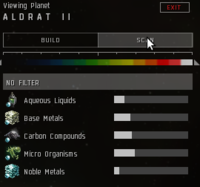 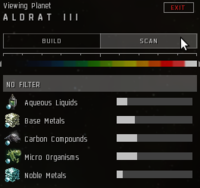 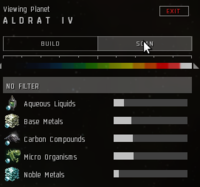
|
| Gas |
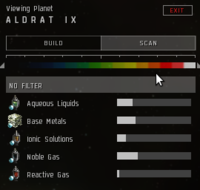 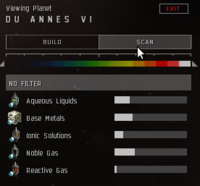 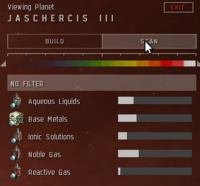 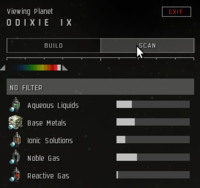
|
| Ice |
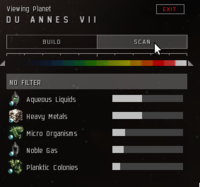 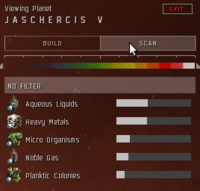 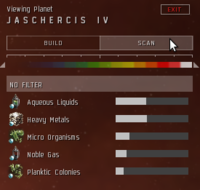
|
| Lava |
  
|
| Oceanic |
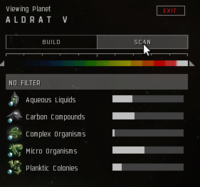 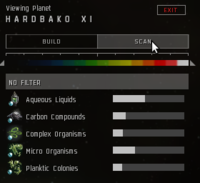
|
| Plasma |
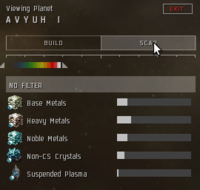  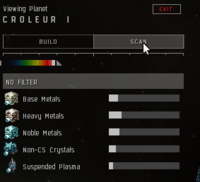 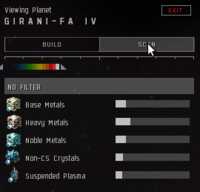
|
| Storm |
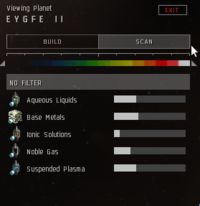 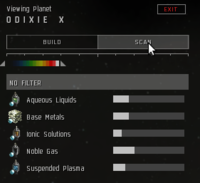 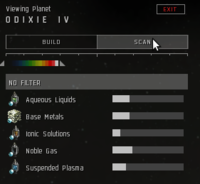
|
| Temperate |
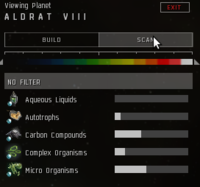 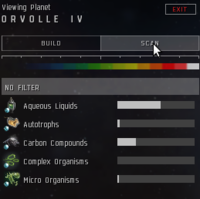 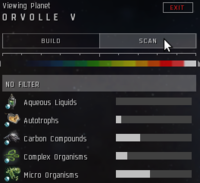 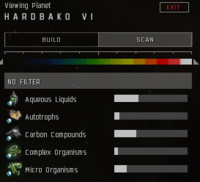 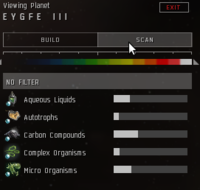
|
Resource Mixes
Moving on to the more complicated question of looking at resource mixtures, we now consider the possibility of not just feeding other producers of the higher levels of production with raw materials, but trying to make something completely ourselves, preferably on one planet. We know from the Planetary Commodities page that there are some planets that can completely make a particular product. For example,
- Livestock are made from Biofuels (made from Carbon Compounds) and Proteins (made from Complex Organisms). Both of these could be found on Oceanic and Temperate planets. Looking at the abundances, both are fairly variable, and so it bears some work hunting for one with a balance of both. The sampling on 0.0 suggests that on Oceanic worlds one is more likely to hit Carbon Compounds being off the chart with decent Complex Organisms than vice versa.
- Test Cultures come from Water and Bacteria, so Barren, Ice, Oceanic or Temperate planets could produce these completely.
- Nanites come from Micro Organisms and Base Metals, a combination only available on Barren worlds.
Note that Eygfe III would be a good planet to produce Test Cultures, since it has equal parts Micro Organisms (makes Bacteria) and Aquaeous Liquid (makes Water), meaning that you are not filling your storage with extra stuff you do not need. This would of course depend on the exact distribution of those two resources as well as their abundance. If we found a planet that has 30% Aqueous Liquids, and 30% Micro Organisms, this is a good choice. However, what if we found a planet with 30% Aqueous Liquids and 40% Micro Organisms. If we are willing to collect the excess Micro Organisms on a regular basis, we can produce the Test Cultures, and have a small amount of extra revenue selling Bacteria to producers of Nanites, sited on Barren worlds where the abundance of Micro Organisms is less than on the Oceanic world we chose. (We obviously would not be selling to people on Aldrat II, III, or IV, who have chosen a good planet for making Nanites (equal quantities of Micro Organisms and Base Metals), threatening to make this an appallingly poor teaching example.)
Planet Radius
Planets come in different sizes - the radius of each planet can be looked up in its attribute tab. This is an extremely important variable, as it determines the cost of each and every link that is built between planetary buildings. The size of planets varies greatly, but mainly depends on the type of planet; for example, Gas planets tend to always be much larger than most other planets, while Lava planets are uniformly small.
The difference in link costs is massive and should not be underestimated. While on a Lava planet with a radius of 2,000 km, a link to an adjacent structure will cost less than 20 MW of powergrid, that same link costs in excess of 100 MW on a Gas planet with a 30,000 km radius. Since Gas planets have been observed to come in sizes up to and exceeding 150,000 km in radius, this has significant impact on the potential productivity of any colony - in some cases it may be an even more important factor than the abundance of resources on the planet and should thus definitely be considered when searching for suitable candidates for colonization.
Abundance Project
To expand on the concepts explored on this page we desire data - lots of it! To be able to calculate accurate averages and expected resource outputs we want to record resource bar counts from all types of planets and sec levels, as well as extractor output.
Data will be solicited from anybody willing to share and submit it, likely via a Google doc + form when we get one up.
The form is in beta testing, and is available at Abundance Project.
Resource bar counts
Our going theory is that the resource bars on the initial planet scan view are linear in expected resource output. Thus a simple "percentage bar full" count will be very useful in estimating said output. Do note that the bars cannot necessarily be compared between resources - some resources are gathered in a few tight spots, so despite a planet having very little of it overall, the few hot spots are comparatively very rich. This can also vary for the same resource across multiple planet types.
Ultimately somebody will probably code an image / screenshot scraper utility that'll calculate the percentages from you simply by looking at a planet or running the utility on a screenshot. While we'd love to provide that it would take some time and effort.
In the meanwhile there is a far simpler, if more brute-force approach, that will gain us the same data: Simply measure the width of the filled part of a resource bar / total width of resource bar * 100 = percentage of resource availability. No, put the ruler down from the monitor, not that brute-force and inaccurate! We resort to fancy technology!
If you're interested in this kind of effort, grab a screenshot / image editor app such as Greenshot and it'll be as easy as hitting a key, selecting the filled resource bar box and note a number of pixels that pop up. That number divided by total pixels wide and multiplied by 100 will then get you the percentage. (There are 100 pixels in the resource bar at 1280x1024, and I believe other resolutions, so the calculation is pretty simple.)
The planet + sec level (or WH class) + resource + percentage will then be entered into a growing database to be used to calculate averages and determine if there is a substantial difference between sec levels within the hisec / lowsec / nullsec categories, as well as WH class.
Data entry details coming soon!
Extractor output
With percentages in hand we can then compare the same resource being extracted on multiple different planets with differing percentages. In theory a planet with 20% abundance of resource X should produce twice as much per cycle (any duration) as a planet with 10% of resource X - with the caveat that at this point you'll also have to set the contrast bar to the exact same level and find a white peak looking as similar between the two planets as possible.
This will take scanning and placement of actual extractors, so it will take more in-person work than the resource bars, since that can be done by anybody anywhere without any sort of skills.

